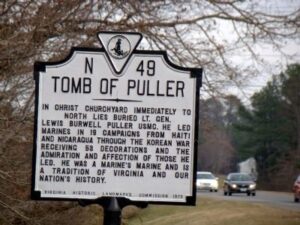
Lewis Burwell “Chesty” Puller was one of the most decorated Marines in American history. He was born here in Virginia and left behind a legacy of honor and service. From a very early age, Puller had a desire to serve his country. As a boy he heard stories and anecdotes from Civil War veterans and looked up to them with great admiration.
A Marine officer and enlisted man for 37 years, General Puller served at sea or overseas for all but ten of those years, including a hitch as commander of the “Horse Marines” in China. Excluding medals from foreign governments, he won a total of 14 personal decorations in combat, plus a long list of campaign medals, unit citation ribbons, and other awards. In addition to his Navy Crosses (the next-highest decoration to the Medal of Honor for Naval personnel), he holds its Army equivalent, the Distinguished Service Cross.
He was awarded the Distinguished Service Cross and his fifth Navy Cross for heroism in action as commander of the 1st Marines, 1st Marine Division, during the bitter fight to break out of Korea’s Chosin Reservoir area. The latter citation, covering the period from 5-10 December 1950, states in part:
“Fighting continuously in sub-zero weather against a vastly outnumbering hostile force, (the then) Colonel Puller drove off repeated and fanatical enemy attacks upon his Regimental defense sector and supply points. Although the area was frequently covered by grazing machine gun fire and intense artillery and mortar fire, he coolly moved among his troops to insure their correct tactical employment, reinforced the lines as the situation demanded and successfully defended his perimeter, keeping open the main supply routes for the movement of the Division.
During the attack from Koto-ri to Hungman, he expertly utilized his Regiment as the Division rear guard, repelling two fierce enemy assaults which severely threatened the security of the unit, and personally supervised the care and prompt evacuation of all casualties.

By his unflagging determination, he served to inspire his men to heroic efforts in defense of their positions and assured the safety of much valuable equipment which would otherwise have been lost to the enemy. His skilled leadership, superb courage and valiant devotion to duty in the face of overwhelming odds reflect the highest credit upon Colonel Puller and the United States Naval Service.”
Serving in Korea from September 1950 to April 1951, the general also earned the Army Silver Star Medal in the Inchon landing, his second Legion of Merit with Combat “V” in the Inchon-Seoul fighting and the early phases of the Chosin Reservoir campaign, and three Air Medals for reconnaissance and liaison flights over enemy territory.
General Puller also fought with the 1st Marine Division in the World War II campaigns on Guadalcanal, Eastern New Guinea, Camp Gloucester and Peleliu, earning his third Navy Cross and the Bronze Star and Purple Heart Medals at Guadalcanal, his fourth Navy Cross at Cape Gloucester, and his first Legion of Merit with Combat “V” at Peleliu. He won his first Navy Cross in November 1930, and his second in September and October 1932, while fighting bandits in Nicaragua.
The general’s last active duty station was Camp Lejeune, North Carolina, where he was commanding the 2d Marine Division when he became seriously ill in August 1954. After that he served as Deputy Camp Commander until his illness forced him to retire. He died on 11 October 1971 in Hampton, Virginia after a long illness.
A Historical Road marker is placed near the sight of the General’s Tomb in Christ Churchyard at the intersection of General Puller Highway (Virginia Route 33) and Christchurch Drive, on the left when traveling east on General Puller Highway.
It reads:
In Christ Churchyard immediately to north lies buried Lt. Gen. Lewis Burwell Puller USMC. He led Marines in 19 campaigns from Haiti and Nicaragua through the Korean War receiving 53 decorations and the admiration and affection of those he led. He was a Marine’s Marine and is a tradition of Virginia and our nation’s history.
(Information sourced from the Marine Corps University and the Historical Marker Database.)


